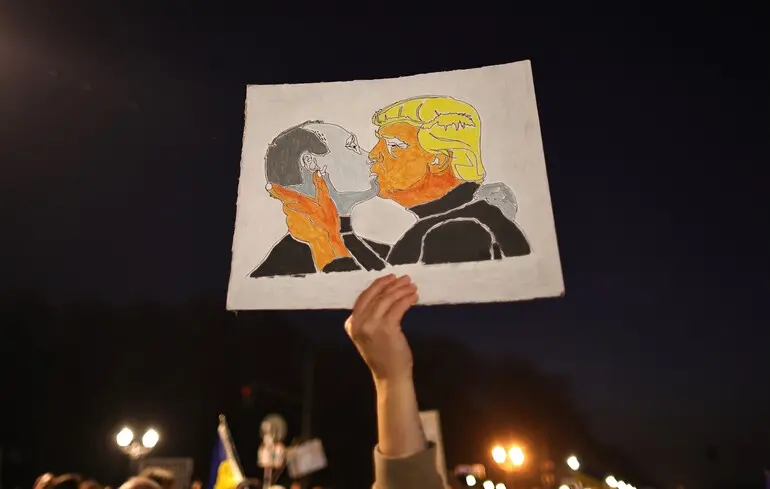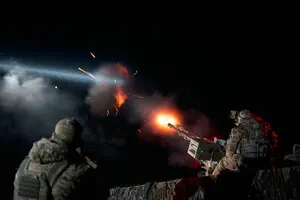Putin's Nine Steps Toward Trump and «Yalta 2.0»

With our Ukrainian-centred mindset and being at war with Russia, it seems to us that any communication between Donald Trump and Vladimir Putin is about Ukraine.
Let's dare to assume that the dialog on restoring peace in Ukraine has become just an excuse to divide other countries, territories and resources.
The Kremlin is trying to build a world order in its sole discretion, to achieve the withdrawal of American troops from Europe, to establish control over Ukraine and to restore the Russian empire. In short, to realize the “Yalta 2.0” project. To do this, Russia is luring the US with the appearance of strategic stability in Europe with established zones of influence and playing on its rapprochement with China, Iran, the DPRK and Washington's desire to detach Moscow from Beijing.
Putin is about to get what he dreamed of, but didn't believe in — the severance of transatlantic ties between America and Europe. And to keep what he has won in Ukraine, Putin is ready to offer Trump any kind of goodies. And if in Jeddah our side agreed with the Americans on mining resources in Ukraine and the terms of the ceasefire, then at the talks in Riyadh the Russians, using Trump's sympathy for Putin and love of deals, got Washington “hooked” on Russia's business opportunities.
What projects is Putin offering? Here's what we know from official reports and my own confidential sources.
Firstly, Putin has already publicly offered the Americans cooperation in mining rare earth metals in Russia, as well as 2 million tons of Russian aluminum and the possibility of joint production in Siberia.
According to the United States Geological Survey, Russia ranks fifth in the world in rare earth metal reserves. However, Russia's share in the global production of rare earth metals is less than 1 percent: the development of its deposits is hampered by the fact that they are located in hard-to-reach areas of Siberia and the Arctic, where there is no relevant industrial infrastructure.
Nevertheless, so far the Kremlin's strategy is working. After all, Russia has more to offer than Ukraine. And even what Ukraine has in the event of a seizure of its entire territory. Putin has already said that Russia is ready to attract “foreign partners” to “new territories.” But Putin is not only seducing Trump with promises to allow American companies to develop rare earth metal deposits in Russia or in the occupied part of Ukraine.
Secondly, the Kremlin is luring the White House with proposals for joint exploration and development of mineral deposits in Siberia (particularly in Yakutia and Krasnoyarsk Krai). And the proposals will not be limited to aluminum. For example, the United States is also interested in palladium: Russia remains the second largest supplier of this metal to the US, trailing only the Republic of South Africa.
Thirdly, the Kremlin offers Washington cooperation in developing oil and gas fields in the Arctic. The US Geological Survey estimates that more than 10 percent of the world's undiscovered oil reserves and more than 30 percent of undiscovered gas reserves are concentrated in the Arctic.
According to Bloomberg, at the Russian-American talks in Riyadh, the two sides discussed the exploration of Arctic natural resources and the development of trade routes. Moscow itself benefits from this: Russia does not have the technology to produce oil on the Arctic continental shelf in harsh conditions. For this purpose, it needs Western technologies. At the same time, the United States views the region as a strategic rivalry with Russia and China, and Washington intends to drive a wedge between Moscow and Beijing through cooperation in the Arctic.
In turn, representatives of Russian oil and gas companies (in particular, Novatek) are trying to woo American and European partners by enticing them to develop fields in Russia.
Fourthly, according to the information obtained by ZN.UA, as part of the joint development of the Arctic, the Russians also offered the Americans cooperation in the construction of joint floating nuclear power plants and nuclear icebreakers.
Fifthly, if the Americans get access to Siberian and Arctic fields, they can transport Russian gas through Nord Stream-2. According to Bild, Trump's special envoy Richard Grenell has already held secret talks in Switzerland on the launch of the Nord Stream-2 pipeline. According to the publication, the US and Russia are discussing an agreement in which Washington would mediate Russian gas supplies to Germany through the pipeline. The agreement is expected to involve US companies rather than the US government.
Sixthly, Moscow could capitalize on Washington's interest in Russian nuclear fuel. Russia controls nearly 50 percent of the world's uranium enrichment capacity and has successfully worked for years to undermine the US nuclear energy supply chain by dumping enriched uranium products on world markets. According to Bloomberg, as of spring 2025, Russia provides about 25 percent of uranium fuel for US reactors.
Seventhly, it is possible that the Russian negotiating team will sell the Trump administration on economic cooperation in Africa: Moscow has weaved a network of loyal regimes over the past decade, especially in Central African Republic, Burkina Faso, Mali, Chad and Niger. The Kremlin could offer the White House access for US companies to natural wealth in those African countries where Russia holds a dominant economic and security position.
Eighthly, Moscow will try to lure Trump, who is influenced by Elon Musk, with space cooperation: the US president has promised to plant the American flag on Mars and “even far beyond.” Although Russia has long been losing ground in the space industry, Moscow can nevertheless offer Washington the following: an obsolete but reliable backup launch vehicle (e.g., the Soyuz-2); a spare launch infrastructure; and remaining technological developments and rocket parts from Soviet times.
Ninthly, Moscow assumes that after the peace agreement with Kyiv is concluded, Western companies will gradually return to Russia and may receive customs and other incentives to facilitate their access to the Russian market. However, political and other risks remain. In particular, if the EU and UK sanctions remain in place, the risks for banks and Western companies will still be very high.
What does Putin need in return, besides Ukraine and the drawn out spheres of influence?
At the bilateral level, Russia is interested, firstly, in establishing full diplomatic relations with the United States: over the years of confrontation, Moscow and Washington have severely reduced the staff and network of their institutions. Secondly, Russia is interested in the lifting of sectoral and personal sanctions against Russia. Not so long ago, Russian presidential spokesman Dmitry Peskov defined the priorities as follows: first comes the normalization of embassy operations, then settlement of the conflict in Ukraine and after that economic cooperation.
A week ago, US-Russian talks were held in Istanbul, devoted to “bilateral relations” and “normalization of embassy work.” They also discussed the issue of restoring the embassy staff, which had been reduced over the past decade after a series of mutual expulsions of diplomats. The result of the meeting was Washington's granting of an agreeman for the appointment of Alexander Darchiev, director of the North Atlantic Affairs Department of the Russian Foreign Ministry, as ambassador to the United States. A few days later, Putin signed a decree on his appointment.
Obviously, Moscow is also interested in restoring the work of the consulates general in Seattle and San Francisco, as well as the getting back a number of buildings in the United States. The new consulates are needed not so much to provide better consular services to Russian citizens abroad as to facilitate the intelligence activities of GRU (military intelligence) and SVR (Foreign Intelligence Service) agents working under diplomatic cover. It is in Washington's interest to reopen consulates in St. Petersburg, Vladivostok and Yekaterinburg.
In addition, the Kremlin is also interested in further prisoner exchanges.
As for restrictive measures, despite Trump's threats to impose tariffs against Russia, his advisers are simultaneously developing a plan to ease sanctions against Moscow. The White House, in particular, is discussing the lifting of the oil ceiling, which prohibits companies from Western countries from transporting and insuring oil bought from Russia at a price higher than $60 per barrel. Bloomberg and Reuters sources cite Russia's agreement to conclude a peace deal with Ukraine as a condition for easing sanctions.
Putin is sowing destruction and death in Ukraine both for sadistic pleasure and in order to revise the existing world order and redistribute the world into zones of influence in the “Yalta 2.0” format. So far, Putin has succeeded in playing on the strings of Trump's soul and it seems that the point of no return has been passed. In place of the big chessboard, a large cutting table is being set, at which Vladimir Putin and Donald Trump, will also be joined by Xi Jinping and Narendra Modi.
Please select it with the mouse and press Ctrl+Enter or Submit a bug















 Login with Google
Login with Google